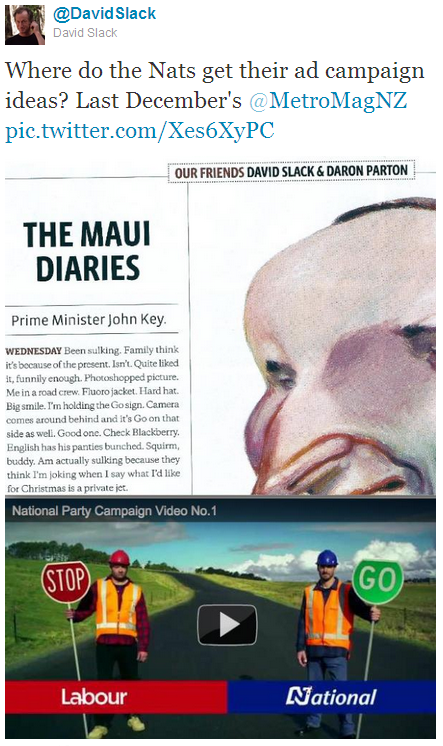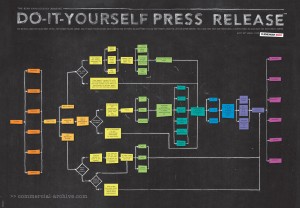A curious post from Marty G at The Standard, who asks: “as newspapers die?” This is part of a wider debate about the future of the media, which I’d like to expand beyond just newspapers. As a caution to those who would conflate ‘newspapers are dying’ with ‘the media is dying’, I would suggest that the demise of the mainstream media is, in words incorrectly attributed to Mark Twain, greatly exaggerated. Fundamentally this comes down to the following:
1. If people care about it, it can likely be profitably monetised.
2. If it can be profitably monetised, big business will eventually come to dominate it.
3. The existing newsgathering infrastructure, brand authority, networks, subscriber bases and institutional expertise are still held almost exclusively by big business.
Big business may not be good at innovating, but it is very good indeed at buying innovation and covering the last mile. That’s what it’ll do, and in some cases, what it’s doing already.
There will be changes — in terms of how content is created and distributed, to the revenue model and in particular to the specific media consumed — but fundamentally the mainstream news media will continue to do what they do, which is tell people what they need to know.
The media do not predominantly provide consumers with a good — news or information or something to wrap fish and chips in or something to watch while eating dinner) — rather, they provide a service — a filtering system which sieves out and highlights the things which people need to know to function in their social and professional and ideological worlds. There’s already more news and information out there than anyone can possible pay attention to. We all have our preferred filtering systems — The Standard and Kiwipolitico are two; who you choose to follow on Twitter is another; whether you wake up to Morning Report as I do or Marcus Lush or The Rock or Southern Star, you’re relying on those sources to give you the information you need to function competently in your world that day, and in the days to come. This is the Ralph’s Pretty Good Grocery principle: “If you can’t find it at Ralph’s, you can probably get along (pretty good) without it”. At present, mainstream media filtering models are more advanced than they’ve ever been — but extremely crude by comparison to the sorts of models employed in new media.
Adopting the filtration models which are being developed in new media will require media companies to adopt some of those media forms, and abandoning the old forms. To take one thing (there are plenty of others) which newspapers, radio and television don’t really do at all: interactivity. So we’re going to see things become more interactive, and that interactivity become part of the filtration system. This is how Google’s advertising functions: your usage choices are a source of data about you, and that data is a pretty good predictor of what you’ll click next. That’s good for advertisers, because it offers them a chance to sell you stuff you might want, and it’s good for you, because of all the zillions of pieces of media out there in the world, it allows a media provider to better determine which are more likely of interest to you.
We’ll also see much more device integration, and in particular the development of e-reader hardware which acts and behaves like paper, and the development of news products which use that hardware to mimic newspapers in function — providing the visual grammar of headlines, columns and images on a broadsheet or tabloid page, a form which is very highly developed and so well-understood as to barely be considered a semantic form any more (like continuity editing, or 4/4 time) — but which is almost entirely absent from existing internet news media. I understand that Apple Computer has on order a couple of million high-resolution low-power 10-inch touchscreen LCDs to make a next-generation reader device for market in the next 12 months or so.
But these things are largely cosmetic. Overall, the fundamental nature of the media market will not change. Some of the big companies might die or fall apart, but they’ll be replaced. It won’t be independents and startups for ever, and there will never be a persistent community-of-knowledge citizen-journalists-ruling-the-roost utopia such as many in the blogosphere so desperately wish for (because it would allow them to quit their jobs and get paid for doing this full-time). The main reason for this is that news costs money, whereas opinion (i.e, 90% or more of bloggery) is mostly free but is reliant on news. The money for the news machine comes from the interesting fact that, in the commercial media industry, the ‘product’ and ‘consumer’ are the reverse of what most people think they are. The ‘product’ is not programmes or articles or news (that’s a service); and the ‘consumer’ is not the person reading, watching or listening. That person — you, and me, and everyone else who consumers the media — is the product, and the consumer of commercial media services is the advertiser whose products you also consume. The media, by functioning as an effective filtering system, serves you up content you want and serves up your eyeballs, earholes, networks and ultimately your wallets to advertisers who pay the media handsomely for doing so. Everyone wins — or at least, everyone goes away thinking they’ve gotten a good deal. This model, at a fundamental level, is not under threat, because there is no other ready means of monetising news. That’s not to say it will always be so. It’s possible that a media business model will emerge which doesn’t rely on advertising, but one way or the other, someone is paying, and if it’s not the advertisers paying for you, then in all likelihood it will be you paying for yourself. How much would you pay? Would that be enough? These are real questions, because talk might be cheap, but news ain’t.
L




